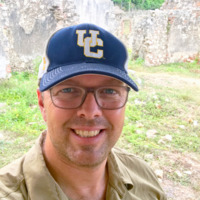
J. Cameron Monroe
Professor J. Cameron Monroe earned a B.A. from UC Berkeley (1995), M.A. from UCLA (1999), and PhD from UCLA (2003), all degrees in Anthropology. Between 2004 and 2006, he was a Postdoctoral Fellow in the Departments of African and African American Studies, Anthropology, and History at Washington University in St. Louis. He joined the Department of Anthropology at UC Santa Cruz in the Fall of 2006. He has participated in archaeological field research in Armenia, Belize, Bénin, Haiti, Israel, Sudan and the United States (California and Virginia).
Professor J. Cameron Monroe’s research broadly examines political, economic, and cultural transformation in West Africa and the Diaspora in the era of the slave trade. He has conducted longterm research in the Republic of Bénin in West Africa (The Abomey Plateau Archaeological Project). This project explores the the political economy of landscape and the built environment and the nature of urban transformation in West Africa during the era of the trans-Atlantic slave trade. In 2015 he initiated a comparative project on the materiality of power and political sovereignty in post-revolutionary Haiti. This project (The Milot Archaeological Project) examines the royal palace site of Sans-Souci in its broader political and economic context in the Kingdom of Hayti, a short-lived experiment in political order in the wake of the Haitian revolution.
Address: Department of Anthropology
321 Social Sciences 1
University of California, Santa Cruz
Santa Cruz, CA 95064
Professor J. Cameron Monroe’s research broadly examines political, economic, and cultural transformation in West Africa and the Diaspora in the era of the slave trade. He has conducted longterm research in the Republic of Bénin in West Africa (The Abomey Plateau Archaeological Project). This project explores the the political economy of landscape and the built environment and the nature of urban transformation in West Africa during the era of the trans-Atlantic slave trade. In 2015 he initiated a comparative project on the materiality of power and political sovereignty in post-revolutionary Haiti. This project (The Milot Archaeological Project) examines the royal palace site of Sans-Souci in its broader political and economic context in the Kingdom of Hayti, a short-lived experiment in political order in the wake of the Haitian revolution.
Address: Department of Anthropology
321 Social Sciences 1
University of California, Santa Cruz
Santa Cruz, CA 95064
less
InterestsView All (28)
Uploads
Books by J. Cameron Monroe
Ce volume incorpore des sources historiques, ethnographiques, historiques de l'art et archéologiques pour examiner la relation entre la production de l'espace et l'ordre politique dans le royaume ouestafricain du Dahomey pendant la tumultueuse ère atlantique. Le Dahomey, situé dans l'actuelle République du Bénin, apparaît à cette époque comme l'un des principaux agents de la traite négrière transatlantique et un exemple de la formation d'un État ouest africain. S'appuyant sur treize ans de travail de terrain ethnohistorique et archéologique en République du Bénin, la thèse centrale de ce volume est que les rois dahoméens ont utilisé des tactiques spatiales pour projeter le pouvoir et atténuer la dissidence sur leurs territoires. J. Cameron Monroe soutient que ces tactiques ont permis aux rois d'exploiter économiquement leurs sujets et de promouvoir un sens de l'inévitabilité historique du pouvoir royal, et de naturaliser la distance sociale entre les gouvernants et les gouvernés. J. Cameron Monroe est professeur agrégé d'anthropologie à l'Université de Californie à Santa Cruz et directeur du projet de recherche sur le plateau d'Abomey en République du Bénin, en Afrique de l'Ouest. Ses recherches portent sur la transformation politique, économique et culturelle de l'Afrique de l'Ouest et de la diaspora africaine à l'époque de la traite des esclaves. Son projet de recherche (Projet Archéologique du Plateau d'Abomey, Bénin) porte sur l'économie politique du paysage et de l'environnement bâti, et sur la nature des transformations urbaines en Afrique de l'Ouest à l'époque atlantique. Il a publié le
Papers by J. Cameron Monroe